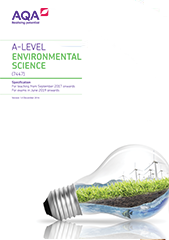Scheme of assessment
Find past papers and mark schemes, and specimen papers for new courses, on our website at aqa.org.uk/pastpapers
This specification is designed to be taken over two years.
This is a linear qualification. In order to achieve the award, students must complete all assessments at the end of the course and in the same series.
A-level exams and certification for this specification are available for the first time in May/June 2019 and then every May/June for the life of the specification.
All materials are available in English only.
Our A-level exams in Environmental Science include questions that allow students to demonstrate their ability to:
- demonstrate knowledge and understanding of the content developed in one section or topic, including the associated mathematical and practical skills or
- to apply mathematical and practical skills to areas of content they are not normally developed in or
- draw together different areas of knowledge and understanding within one answer.
A range of question types will be used, including those that require extended responses. Extended response questions will allow students to demonstrate their ability to construct and develop a sustained line of reasoning which is coherent, relevant, substantiated and logically structured. Extended responses may be in written English, extended calculations, or a combination of both, as appropriate to the question.
Aims
Courses based on this specification must encourage students to:
- develop essential knowledge and understanding of different areas of environmental science and how they relate to each other
- develop and demonstrate a deep appreciation of the skills, knowledge and understanding of the scientific methods used to investigate the environment
- develop competence and confidence in a variety of practical, mathematical and problem solving skills related to environmental issues and the sustainable use of resources
- understand the importance of basing decisions on reliable data which allows evidence-based analysis of environmental issues
- develop interest in and enthusiasm for the subject, including developing an interest in further study and careers associated with the subject
- understand how society makes decisions about environmental issues and how these contribute to the success of the economy and society.
Assessment objectives
Assessment objectives (AOs) are set by Ofqual and are the same across all A-level Environmental Science specifications and all exam boards.
The exams will measure how students have achieved the following assessment objectives.
- AO1: Demonstrate knowledge and understanding of scientific ideas, processes, techniques and procedures, including in relation to natural processes/systems and environmental issues.
- AO2: Apply knowledge and understanding of scientific ideas, processes, techniques and procedures, including in relation to natural processes/systems and environmental issues.
- AO3: Analyse, interpret and evaluate scientific information, ideas and evidence, including in relation to environmental issues, to make judgements and draw conclusions.
Assessment objective weightings for A-level Environmental Science
| Assessment objectives (AOs) | Component weightings (approx %) | Overall weighting (approx %) | |
|---|---|---|---|
| Paper 1 | Paper 2 | ||
| AO1 | 17–19 | 14–16 | 30–35 |
| AO2 | 19–21 | 20–22 | 40–45 |
| AO3 | 11–13 | 13–15 | 25–30 |
| Overall weighting of components | 50 | 50 | 100 |
10% of the overall assessment of A-level Environmental Science will contain mathematical skills equivalent to Level 2 or above.
At least 15% of the overall assessment of A-level Environmental Science will assess knowledge, skills and understanding in relation to practical work.
Assessment weightings
The marks awarded on the papers will be scaled to meet the weighting of the components. Students’ final marks will be calculated by adding together the scaled marks for each component. Grade boundaries will be set using this total scaled mark. The scaling and total scaled marks are shown in the table below.
| Component | Maximum raw mark | Scaling factor | Maximum scaled mark |
|---|---|---|---|
| Paper 1 | 120 | x 1 | 120 |
| Paper 2 | 120 | x 1 | 120 |
| Total scaled mark: | 240 | ||
